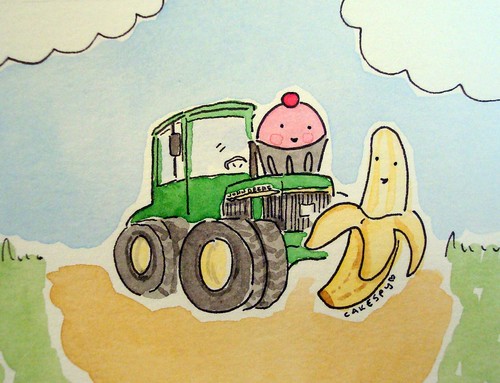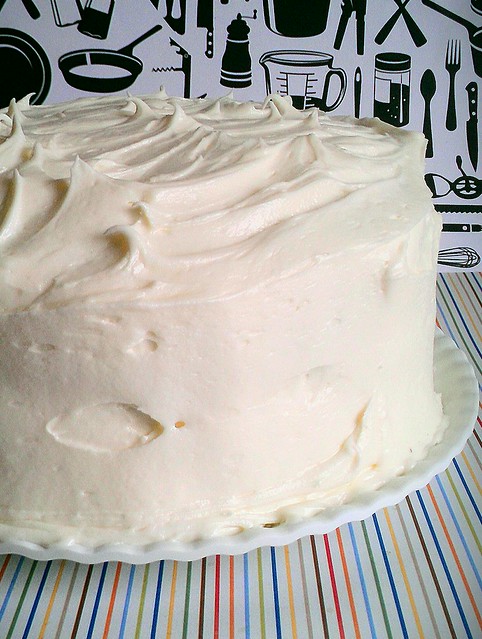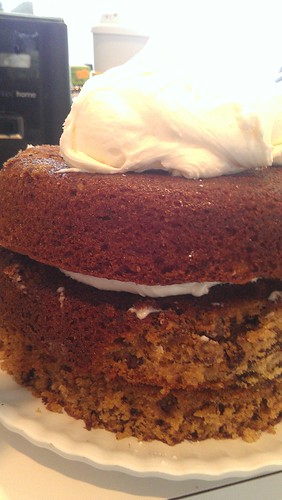Talk about things that will make you hum a happy tune: how about this moist banana spice cake, more sophisticated and delicious than any banana bread could hope to be, covered with swaths of cream cheese frosting ? Having trouble picturing it? An enlightened baker introduced me to the cake as being “like carrot cake, but with bananas.” While it's not quite that exact, it gives you a pretty good idea of what to expect.
The name hummingbird cake is a relatively recent phenomenon; the first known recipe published with this title is from the 1970s, when it appeared in Southern Living magazine. This doesn't imply that the cake was created out of the blue in the '70s; it's more likely that the recipe had been kicking around the South for years, but that it went under various names.
And it's still the South where this sweet reigns supreme; hummingbird cake is most commonly found below the Mason-Dixon line, or on the menus of restaurants specializing in Southern cuisine. While it's still less known than its famous layer-cake cousins the carrot cake and red velvet cake, it's certainly gaining popularity in bakeries and cupcake shops all around the United States.
The cake came to the South from even further south--Jamaica, in fact, where a similar cake, made with earthy spices and flavorsome native bananas proliferates[diff word? Proliferate means to reproduce or multiply]. There, it's called Doctor Bird Cake, after a particularly rare type of swallow-tailed hummingbird. As the recipe immigrated north, it was sometimes referred to as “Jamaican Cake,” but especially following the aforementioned Southern Living feature, became far more popular as “Hummingbird Cake”.
Regardless of whether you want to call it Doctor Bird or Hummingbird, why name this cake after a bird at all? Personally, I find an anecdotal reason most pleasing. The gist? Bake this cake in a house full of people, and see what happens while you bake it, while you frost it, and especially when you serve it. Chances are, a crowd will descend upon the cake, not unlike hummingbirds drawn to sweet nectar.
When baking this recipe, take care to not overmix the batter. Like banana bread, you want to handle it as gently as possible. Additionally, you want your bananas to be very ripe--the tastiest cakes come from bananas that are well past their ideal eating-from-hand stage. If they look brown and almost to the point where you'd want to throw them out, they're at the perfect point to be baked into this cake. And if you're feeling especially festive, substitute Jamaican rum for the vanilla. It's very, very nice.
Hummingbird Cake
Makes one 3-layer 9-inch cake
For the cake:
- 3 cups all-purpose flour
- 2 cups sugar
- 2 teaspoons baking soda
- 1/2 teaspoon salt
- 1 teaspoon ground cinnamon
- 1/4 teaspoon ground nutmeg
- 3 large eggs, beaten lightly
- 1 1/4 cups vegetable oil
- 1 1/2 teaspoons vanilla extract
- 4 oz canned crushed pineapple, drained well
- 1 cup coarsely chopped toasted pecans, plus 1/2 cup toasted pecan halves, for garnish
- 2 cups mashed, very ripe bananas (2 to 3 medium)
For the frosting:
- 1/2 cup unsalted butter, softened
- 8 ounces (1 cup) cream cheese, softened
- 1 teaspoon vanilla extract
- 4 cups confectioners' sugar
Chopped pecans, for garnish
- Preheat the oven to 350 degrees F. Grease and flour three round 9-inch cake pans.
- Sift the flour, sugar, baking soda, salt, cinnamon, and nutmeg together several times. Put into a large bowl and set aside.
- Add the eggs and oil to the dry ingredients. Stir with a wooden spoon until ingredients are evenly moistened. Stir in the vanilla, pineapple, and the pecans. Add the bananas and stir just until combined. The batter will be very thick.
- Divide the batter equally between the prepared cake pans. Bake for 25 to 30 minutes, or until a toothpick inserted into the center comes out clean. Cool in the pan for 10 minutes, then run a small knife around the pan, loosening the edges of the cakes. Turn out onto a cooling rack, and let the cakes cool completely before frosting.
- To make the frosting, in the bowl of a stand mixer fitted with the paddle attachment, combine the cream cheese, butter, and vanilla. Beat at medium-high speed until the mixture has a very smooth consistency; pause occasionally to scrape the sides of the bowl with a rubber spatula. Add the confectioners' sugar 1 cup at a time, mixing well after each addition, until the frosting is smooth and spreadable.
- Place one cake layer, flat side up, on a serving plate; spread 3/4 cup of frosting on top. Leave a half-inch margin all around, as the weight of the second cake layer will push the frosting to the edges. Repeat with the second layer. Place the third cake layer, flat side up, on top of the frosted layers. Frost the sides and then the top; garnish by sprinkling more chopped pecans around the top edges of the cake.
- Serve at room temperature. Because the cream cheese frosting is sensitive to heat, store lightly covered in the refrigerator for up to three days; let come to room temperature before serving.





